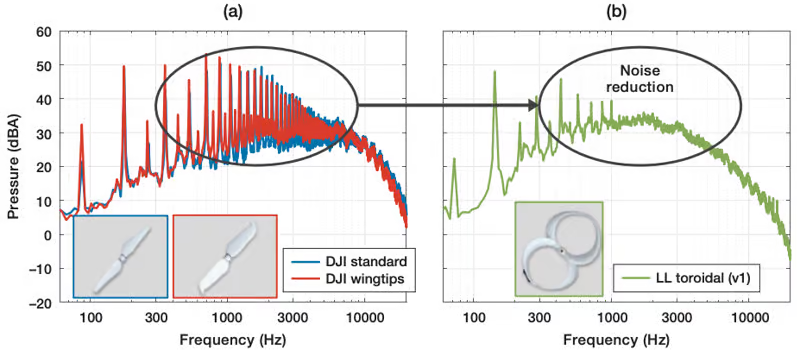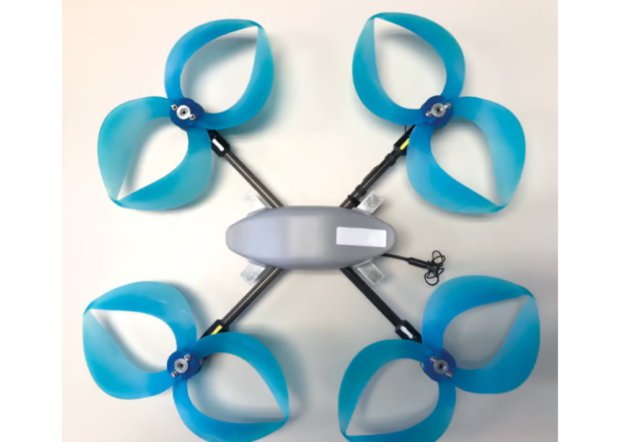The MIT Lincoln Lab has produced some new devices for aircraft and drones that make some impressive efficiency gains and are radically quieter.
“The toroidal propeller allows a small multirotor unpiloted aircraft, or drone, to operate more quietly than current drones that use propeller forms unchanged since the beginning of aviation,” said a statement by the lab.
“By enabling a drone that is less of an acoustic annoyance, this propeller may accelerate the acceptance of such aircraft for a wide range of uses—for example, aerial deliveries, cinematography, industrial or infrastructure inspections, and agricultural monitoring.”
https://youtu.be/M0nMW1E8J90
Two blades looping together
The quiet toroidal propeller consists of two blades looping together so that the tip of one blade curves back into the other. This closed-form structure reduces and controls the drag effects of swirling air tunnels (i.e., vortices) created at the blades’ tips and strengthens the propeller’s overall stiffness. As such, the propeller’s acoustic signature is significantly decreased without affecting its performance.
This has been proven by tests of prototype toroidal propellers on commercial quadcopters that indicated thrust levels comparable to those of conventional propellers at similar power levels. The resulting reduced sound levels allowed toroidal-propeller-equipped drones to function without affecting human hearing at distances half of those encountered in typical operations.
“Propellers, as we know, are pretty loud,” says Dr. Thomas Sebastian, a senior staff member in the Lincoln Lab’s Structural and Thermal-Fluids Engineering Group. “And we can look at wings to see how that works. Back when people were coming up with all kinds of crazy ideas for airplanes in the early 1900s and during World War 2, there were a couple of designs that were basically these ring wings. So I wondered what it would look like if you took a ring wing and turned something like that into a propeller.”
“We came up with this initial concept of using a toroidal shape, this annular wing shape, to hopefully make a quieter propeller,” Sebastian continues. “I had an intern of mine, who was just absolutely phenomenal, run with the idea. He took the concept and created a bunch of iterations using 3D printers.”



Why do we put technology like this out in the public for the Chinese to copy. This design should be sold to defense contractors.
Because we are idiots
Because they are probably horribly and efficient especially at low Reynolds numbers with the added whetted surface area. Like many things, this is not a new idea but seeing soda people that have no background in the underlying technology.
DJI makes some of the finest consumer drones on the planet. I can’t wait to get toroidal props from wherever they are produced.
Anyway China is a branch of the globalists. Saying US Army is saying chinese PLA. Competition between them is encouraged în order to improve the NWO Army. Quod erat demonstrandum.
Globalist? NWO ? What next lizard people?
Other than the killjoy, great article on improving something that’s viewed as good enough.
The Chinese are not idiots. If you go to scholar.google.com and search just about any research paper, the Chinese names are all all the place. This is basic drone aerodynamics, physics, and material science. I think they have that down. China has landed a robotic spacecraft on Mars. This is not rocket science.
Ionic propulsion is literally rocket science. Going from studying ionic propulsion and arriving at toroidal propellers might have been inadvertently discovered in his research resulting in these quieter propellers.
simply because keeping any tech secret doesn’t work.throwing it out puts into the the leading edge making profit. russians kept all their tech top secret which led them nowhere. the us made nearly everything available and an ir camera , ccd, microcontroller chip costs now just a bit more than nothing.
Universities have monetized R&D since the anti-government/”pay no taxes” movement took hold in the public mind. There is not much federal funding for basic research, and private corporations fund selective cutting edge research. In return they get first dibs on commercializing the technology with all that goes with it. Remember Draper Labs? The Chinese bought it.
There’s plenty of tax revenue. The problem is that it’s not rationally prioritized. Nor is it efficiently utilized. With “Current Services Baseline ” There’s no incentive for efficiency. This does not inspire any affection for Government and certainly not in its “stewardship “of citizens’ taxes.
Right!
Kevin, its time for you to respect that Chinese are truly innovative people in quantity and quality. Start learning Chinese and you will may be understand better. They are smart and hard worker and they achieved more in the last 10 years than the people in US or Europe. So try to copy them. This concept of IP is stupid as everything should be available to anyone …
So you only want defense contractors to benefit from scientific discoveries? How about general aviation and consumers? For that matter how about bettering mankind? Plus, the MIT images are already all over the internet with hobbyists already 3D printing experimental versions for drones.
Well I hope you don’t see the high end boat props that have Ben doing this for a few years already.
How about on wind powered electric generators? If they make less noise, then there must be more energy going into the mechanical process. How about in fans for cooling or heating systems? As wind generators, would they be less hazardous to birds because at the highest rotation speed at the tips the fan blades would be tangential to the direction of rotation?
Not necessarily, since all sound is moving air, but not all moving air is sound, you can make it quieter by moving the air in a different way which it seems is what they’ve done.
More likely it will be worse since current propeller have been optimized for many years with performance as the main goal while these are a newer design with focus on acoustics as well.
That energy is likely being consumed in extra vortices. The input energy at the axis is about the same.
I like your idea about birds, the slower speed and the continuous structure would be great but I can’t see these being manufactured 200m across
I wonder how many Chinese spies are at MIT and which one either worked on the project or knows a-lot about it before the project was publicized???
All of them
These props are needed in Ukraine now. Noise is the number one giveaway that a drone is near by. The faster these props can be sent to Ukraine the better.
There is already downloadable models:
https://grabcad.com/library/145mm-toroidal-drone-propeller-1
Nicolas. Link doesn’t work. Can you repost
I don’t find anything via that link. Can you provide a better one?
Yea they took down the file… hmm wonder why…
I never understand why billion years of evolution of life forms never exploited rotation as a method for controllable movement.
I have doubt that nature is any good designer as these MIT people.
Because nature isn’t designed…
That is a true observation nature is a matter of evolution where pressure to survive has forced change and the same can be said for this development, designers have seen the need out of pressure to evolve a better system
You mean like the bacterial flagellum?
Darn, you beat me to the bacteria flagellum. Nothing new under the sun.
simply because keeping any tech secret doesn’t work.throwing it out puts you into the the leading edge making profit. russians kept all their tech top secret which led them nowhere. the us made nearly everything available and an ir camera , ccd, microcontroller chip costs now just a bit more than nothing.
Don’t they need these for ships props?
It’s very noisy down there, I heard the whales and dolphins are quite annoyed…
Yes indeed – they are already in use see:
https://www.sharrowmarine.com/
There’s plenty of tax revenue. The problem is that it’s not rationally prioritized. Nor is it efficiently utilized. With “Current Services Baseline ” There’s no incentive for efficiency. This does not inspire any affection for Government and certainly not in its “stewardship “of citizens’ taxes.
Where can I get some?